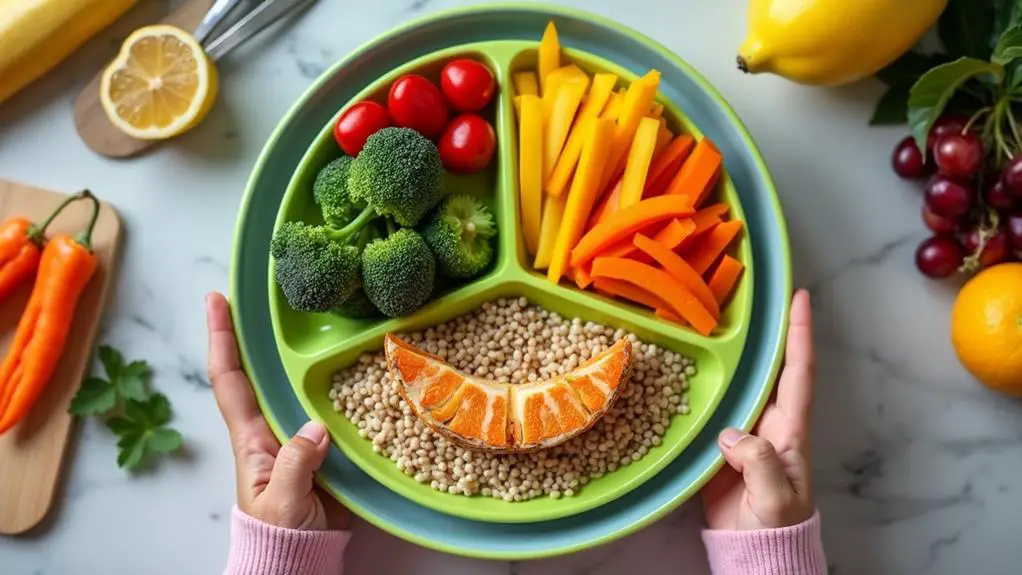Teaching Kids About the Importance of Balanced Meals
Teaching kids about balanced meals is essential for their health and development. You'll want to start by explaining the five main food groups and their importance. Use visual aids like MyPlate to demonstrate portion sizes. Make learning fun with themed meals, grocery store games, and taste tests. Involve children in meal planning and preparation to boost their engagement. Address picky eating by encouraging exploration and using the three-bite rule. Remember, it may take multiple exposures for kids to accept new foods. By teaching these concepts early, you're setting the foundation for lifelong healthy eating habits. There's much more to discover about nurturing your child's nutritional education.
Key Takeaways
- Introduce the five main food groups and their unique nutritional benefits using visual aids like MyPlate.
- Involve children in meal planning and grocery shopping to increase their engagement with balanced nutrition.
- Use fun, interactive methods like themed meals, food-related games, and taste tests to make learning enjoyable.
- Explain how balanced nutrition supports growth, cognitive function, and long-term health in simple terms.
- Address picky eating by encouraging food exploration and implementing strategies like the three-bite rule.
Understanding Food Groups
Regularly teaching kids about food groups is essential for their understanding of balanced nutrition. When you introduce the five main food groups – protein, fruits, vegetables, grains, and dairy – you're laying the foundation for a lifetime of healthy eating habits.
Encourage your children to explore a variety of colorful fruits and veggies, aiming for at least five servings daily. Explain how each food group provides unique nutrients crucial for growth and development.
Use visual aids like the MyPlate model to demonstrate proper portion sizes and how to create a balanced plate. By teaching kids about food groups, you're empowering them to make informed choices about their diet.
This knowledge not only helps them build a balanced diet now but also sets them up for a healthier future.
Benefits of Balanced Nutrition
As children grow, balanced nutrition plays an essential role in their overall development. You'll notice numerous benefits of healthy eating habits in your kids, including improved cognitive function and academic performance. Good nutrition supports strong bones, teeth, and overall health, while reducing the risk of obesity and chronic diseases later in life.
| Benefit | Impact | How to Achieve |
|---|---|---|
| Physical Health | Strong bones, teeth | Include dairy, leafy greens |
| Mental Well-being | Reduced anxiety, depression | Serve nutrient-dense foods |
| Academic Success | Enhanced focus, alertness | Provide balanced meals |
Encourage your children to maintain a healthy weight by teaching them about balanced nutrition. Make grocery shopping a fun learning experience, introducing them to various fruits, vegetables, whole grains, and lean proteins. Aim for at least five servings of fruits and vegetables daily to boost their immune function and promote healthy digestion.
Making Meals Fun

Countless ways exist to make meals fun and engaging for children while promoting balanced nutrition. You can present healthy foods in appealing shapes or colorful arrangements to entice kids to try new options.
Organize themed meals like "Taco Tuesday" or "Fruit Friday" to create excitement around nutritious eating. Incorporate interactive games during grocery shopping, such as scavenger hunts for healthy items, to teach kids about nutritious choices.
Host taste tests featuring various fruits and vegetables, allowing children to discover new flavors in an enjoyable, educational setting. Use colorful charts or stickers to track the variety of foods consumed, turning healthy eating into a fun challenge.
Involving Kids in Meal Planning
Involving children in meal planning is a powerful strategy to foster healthy eating habits and nutritional awareness. When you include your kids in food selection at the grocery store, you're teaching them to read nutrition labels and understand balanced meals.
Let them choose healthy ingredients, and you'll notice they're more likely to try new fruits and vegetables. Assign age-appropriate kitchen tasks during meal preparation to boost their confidence and interest in healthy eating.
Engage your kids in discussions about food choices, encouraging critical thinking about nutrition. Make it fun by implementing challenges like "eating the rainbow" to motivate them to incorporate diverse, colorful produce into their diets.
Addressing Picky Eating Habits

Picky eating habits can be a significant challenge for parents trying to instill healthy eating patterns in their children. To combat unhealthy food choices, encourage your kids to explore a variety of foods by offering diverse options on their plates.
Implement the three-bite rule, asking them to try at least three bites of a new food. Remember, it may take 15 or more exposures before they accept it, so be patient and persistent.
Don't prepare separate meals for picky eaters; instead, maintain consistency by serving the same food to everyone. Involve your children in meal planning and preparation to foster a sense of ownership over their food choices.
Conclusion
You've now got the tools to help your kids develop healthy eating habits that'll last a lifetime. Remember, consistency is key. Take Sarah, a mom who struggled with her picky eater. By involving her son in meal planning and making food fun, she transformed mealtimes from battles into bonding experiences. Within months, her son was enthusiastically trying new foods and understanding the importance of balanced nutrition. You can achieve similar success with patience and creativity.







